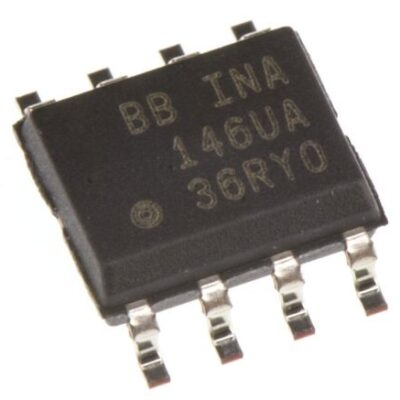SN65HVD1781DR
Part Number: SN65HVD1781DR
Manufacturer: Texas Instruments
Description: IC TRANSCEIVER HALF 1/1 8SOIC
Shipped from: Shenzhen/HK Warehouse
Stock Available: Check with us
ICRFQ.com - Electronic Components Distributor in China Since 2003

Part Number: SN65HVD1781DR
Manufacturer: Texas Instruments
Description: IC TRANSCEIVER HALF 1/1 8SOIC
Shipped from: Shenzhen/HK Warehouse
Stock Available: Check with us
| Datasheet | |
|---|---|
| Category | Integrated Circuits (ICs) |
| Family | Interface – Drivers, Receivers, Transceivers |
| Manufacturer | Texas Instruments |
| Series | – |
| Packaging | Tape & Reel (TR) |
| Part Status | Active |
| Type | Transceiver |
| Protocol | RS422, RS485 |
| Number of Drivers/Receivers | 1/1 |
| Duplex | Half |
| Receiver Hysteresis | 50mV |
| Data Rate | 1Mbps |
| Voltage – Supply | 3.15 V ~ 5.5 V |
| Operating Temperature | -40°C ~ 125°C |
| Mounting Type | Surface Mount |
| Package / Case | 8-SOIC (0.154″, 3.90mm Width) |
| Supplier Device Package | 8-SOIC |
The SN65HVD1781DR is your only sturdy, dependable, and effective half-duplex RS-485 transceiver. These transceivers are built to withstand overvoltage faults caused by incorrect wiring, failed connectors, and improper tool use. They are also ESD-protected with high levels of protection that meet the requirements for the human body model. They are suitable for multipoint applications over lengthy cable runs because they have a differential driver and receiver running off a single power supply. The SN65HVD1781DR is perfect for various applications, including HVAC networks, building automation, security electronics, motion control, telecommunication equipment, and industrial networks. It has a broad common-mode working range and bus-pin fault protection up to 70 V.
The SN65HVD178x devices are made to withstand overvoltage issues such as direct shorts to power sources, incorrect wiring mistakes, failed connectors, crushed cables, and incorrect tool usage. The gadgets have high levels of protection that meet the human body model criteria and are resistant to ESD incidents. A differential driver and receiver are combined in the SN65HVD178x devices, which run on a single power source. The SN65HVD1782 has a bus port suitable for half-duplex (two-wire bus) communication thanks to internal connections between the driver differential outputs and receiver differential inputs.
Thanks to this port’s wide common-mode voltage range, the devices are suitable for multipoint applications over lengthy cable runs. These devices have a temperature range of -40 to 125 degrees. Since these components are pin-compatible with the commercially available SN75176 transceiver, most systems may easily update to them. These devices can operate with a 3.3-V supply and a decreased driver output voltage for low-power applications, and they are fully compliant with ANSI TIA/EIA 485-A with a 5-V supply. See the SN65HVD1785 (SLLS872) data sheet for applications requiring operation over a wide common-mode voltage range.
The SN65HVD178x devices are half-duplex RS-485 transceivers with three different speed classes that can handle data transfer rates of up to 115 kbps, 1 Mbps, and 10 Mbps. These devices are feature-rich, with bus-pin fault protection up to 70 V and a broad common-mode operating range. An active-HIGH driver and an active-LOW receiver are enabled on each device. Disabling the driver and the receiver results in a standby current of less than 1 A.
Internal ESD protection circuits guard the transceiver bus terminals against electrostatic discharges of up to 16 kV (HBM). The operating temperature range for the device is specified to be between -40°C and 125°C.
Modes The differential outputs A and B follow the data input D’s logic states when the driver enable pin, DE, is logic high. B turns low, and A turns high due to a logic high at D. The differential output voltage, VOD, calculated as VA – VB, is positive in this instance. D is low when the output states are the opposite, B is high, A is low, and VOD is negative.
Both outputs become high-impedance when DE is low. The logic state at D is irrelevant under this circumstance. Due to an inbuilt pulldown resistor to ground on the DE pin, the driver is by default disabled (high-impedance) when left open. As a result of the D pin’s inbuilt pullup resistor to VCC, when it is left open while the driver is activated, outputs A and B are switched between being high and low.
Every supply should be buffered with a 100-nF ceramic capacitor as close to the supply pins as possible to ensure reliable operation at all data rates and supply voltages. The linear voltage regulator TPS76350 is appropriate for the 5-V supply.
On-chip IEC-ESD protection is good for laboratory and portable equipment, but it is frequently insufficient for EFT and surge transients in industrial environments. Therefore, external transient protection devices are necessary for a robust and dependable bus node design. High-frequency layout techniques must be used during PCB design because ESD and EFT transients have a large frequency bandwidth ranging from roughly 3 MHz to 3 GHz.
For surge transients up to 1 kV, pure TVS protection is sufficient, but for greater transients, metal-oxide varistors (MOVs) are needed to decrease the transients to a few hundred volts of clamping voltage and transient blocking units (TBUs) to limit transient current to less than 1 mA.
In conclusion, the SN65HVD1781DR devices are a great option for industrial applications requiring half-duplex RS-485 connectivity. They are perfect for use in various industrial situations due to their resilience and adaptability, allowing them to tolerate various environmental and electrical stressors. Furthermore, their interoperability with the widely used SN75176 transceiver makes integrating them into existing systems simple. Design professionals can assure dependable operation and protection against transients and noise in industrial environments by adhering to the advised layout principles and power supply suggestions. With ICRFQ, you may find various economical solutions to buy discount SN65HVD1781DR electronic parts. Please get in touch with them if you want to know more.
WhatsApp us